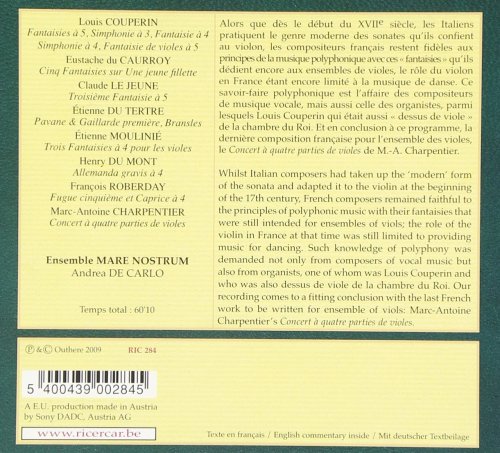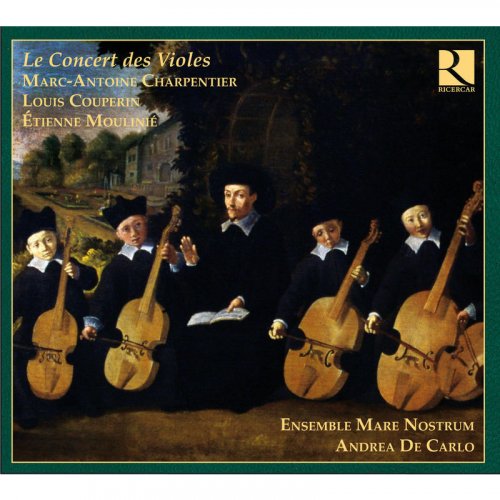
Ensemble Mare Nostrum, Andrea De Carlo - Charpentier, Couperin & Moulinié: Le Concert des Violes (2009)
BAND/ARTIST: Ensemble Mare Nostrum, Andrea De Carlo
- Title: Charpentier, Couperin & Moulinié: Le Concert des Violes
- Year Of Release: 2009
- Label: Ricercar
- Genre: Classical
- Quality: flac lossless +Booklet
- Total Time: 00:59:07
- Total Size: 315 mb
- WebSite: Album Preview
Tracklist
01. Fantaisie de violes à 5
02. Cinq Fantaisies sur « Une jeune fillette » à 3, à 3, à 4, à 4, à 5
03. Troisième Fantaisie à 5 ad imitationem Moduli Benedicta est coelorum Regina
04. Pavane première, Gaillarde première, Bransles 3 et 1 à 4
05. Première Fantaisie à 4
06. Seconde Fantaisie à 4
07. Troisième Fantaisie à 4
08. Allemanda gravis à 4
09. Fugue cinquième et Caprice à 4
10. Simphonie à 3
11. Fantaisie à 4
12. Simphonie à 4
13. Concert à quatre parties de violes: I. Prélude
14. Concert à quatre parties de violes: II. Autre Prélude
15. Concert à quatre parties de violes: III. Sarabande
16. Concert à quatre parties de violes: IV. Gigue angloise
17. Concert à quatre parties de violes: V. Gigue françoise
18. Concert à quatre parties de violes: VI. Passecaille
19. Fantaisies à 5

Whilst Italian composers had taken up the ‘modern' form of the sonata and adapted it to the violin at the beginning of the 17th century, French composers remained faithful to the principles of polyphonic music with their fantaisies that were still intended for ensembles of viols; the role of the violin in France at that time was still limited to providing music for dancing. Such knowledge of polyphony was demanded not only from composers of vocal music but also from organists, one of whom was Louis Couperin and who was also dessus de viole de la chambre du Roi. Our recording comes to a fitting conclusion with the last French work to be written for ensemble of viols: Marc-Antoine Charpentier's Concert à quatre parties de violes.
01. Fantaisie de violes à 5
02. Cinq Fantaisies sur « Une jeune fillette » à 3, à 3, à 4, à 4, à 5
03. Troisième Fantaisie à 5 ad imitationem Moduli Benedicta est coelorum Regina
04. Pavane première, Gaillarde première, Bransles 3 et 1 à 4
05. Première Fantaisie à 4
06. Seconde Fantaisie à 4
07. Troisième Fantaisie à 4
08. Allemanda gravis à 4
09. Fugue cinquième et Caprice à 4
10. Simphonie à 3
11. Fantaisie à 4
12. Simphonie à 4
13. Concert à quatre parties de violes: I. Prélude
14. Concert à quatre parties de violes: II. Autre Prélude
15. Concert à quatre parties de violes: III. Sarabande
16. Concert à quatre parties de violes: IV. Gigue angloise
17. Concert à quatre parties de violes: V. Gigue françoise
18. Concert à quatre parties de violes: VI. Passecaille
19. Fantaisies à 5

Whilst Italian composers had taken up the ‘modern' form of the sonata and adapted it to the violin at the beginning of the 17th century, French composers remained faithful to the principles of polyphonic music with their fantaisies that were still intended for ensembles of viols; the role of the violin in France at that time was still limited to providing music for dancing. Such knowledge of polyphony was demanded not only from composers of vocal music but also from organists, one of whom was Louis Couperin and who was also dessus de viole de la chambre du Roi. Our recording comes to a fitting conclusion with the last French work to be written for ensemble of viols: Marc-Antoine Charpentier's Concert à quatre parties de violes.
As a ISRA.CLOUD's PREMIUM member you will have the following benefits:
- Unlimited high speed downloads
- Download directly without waiting time
- Unlimited parallel downloads
- Support for download accelerators
- No advertising
- Resume broken downloads


